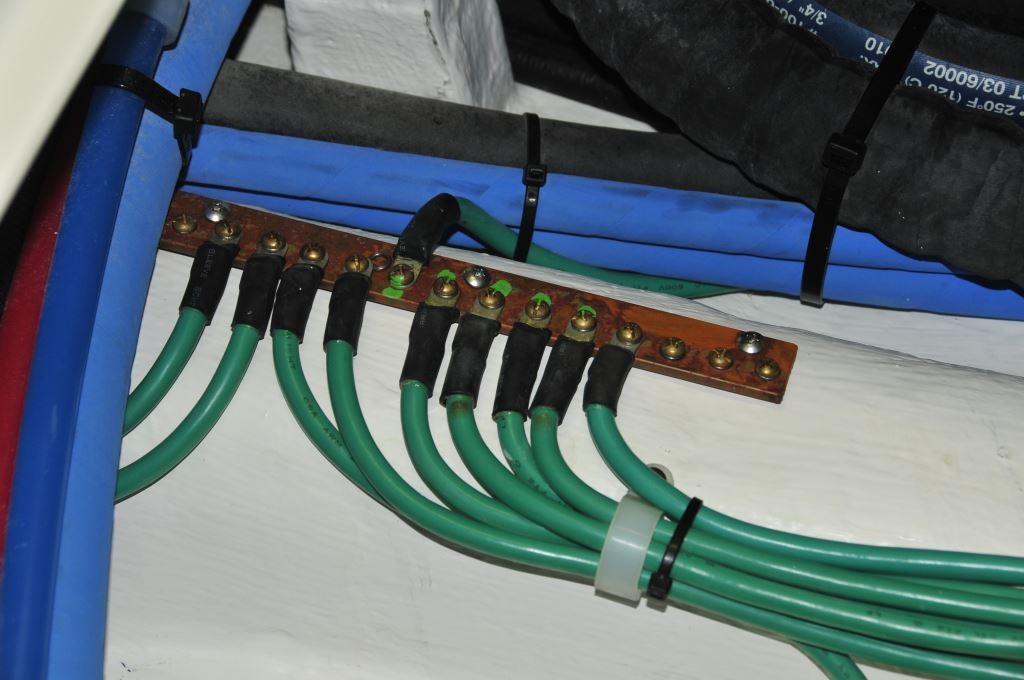From the Masthead
Just as I began to write this column I received an email from a colleague, he manages the physical plant for a large medical complex. Among other things we discussed our shared frustration at the lack of expertise and professionalism among many technicians. He shared a story wherein a factory-trained generator technician spent hours (miss) diagnosing a failed genset battery charger, and then provided a repair quote for $3,400.00. My colleague repaired the problem himself in about 20 minutes; it was literally a single burned connection.
I suggested that the current record low unemployment, as good as it is for the country, and job-seekers, is a silver cloud with a black lining. As sources for qualified staff are depleted, employers are prone to accept less and less capable individuals, that in turn doesn’t bode well for boat owners and consumers (I don’t care for that word, when did we go from “citizens” to “consumers”?). I’ve been guilty of it myself, so I can’t necessarily blame them, you tell yourself you can train them, mold them, and improve them. Sometimes you can.
Beyond technical capacity, and an above average level of curiosity about how things work, and why they fail, those carrying out boat building and repair tasks must also possess solid personal traits, and good work habits. I’ve always believed that if employees have this foundation, they could be trained to do most jobs. Our conversation then turned to exactly what makes for a good employee, which reminded me of a cheat sheet I created for those coming to work at the boat yard I managed.
Every new employee was given a copy of the employee handbook, which was twenty five or thirty pages long. After reading it he or she was asked to sign a document indicating they had read and understood it. Of course no one can remember all the details in a document this long; I wanted to give new hires an indication of what was really important to me, along with the details that spelled the difference between failure and success, in a one page format. I sat at my desk pondering how I could give folks this head start when my eyes passed over a framed photo of my father, standing in front of the Taegu Army Post in Korea, in 1952.

With that inspiration, I created the following.
This business welcomes you as an employee if…
- You report to work on time and are ready to begin working at 7:30AM, and do not depart before 4:00PM without permission.
- You take your AM, PM, and lunch breaks at the appointed time and for the allotted time.
- Your appearance is neat and you are respectful to customers and your fellow employees, and you refrain from using foul language especially when customers are present (that could be any time).
- You report to work with the tools and gear (warm clothing, gloves, foul weather gear etc.) to do your job.
- You do not abuse the telephone or cell phone privileges.
- You take the necessary precautions to protect the boat you are working on while keeping it neat and orderly.
- You clean up after yourself in the shop, yard and skiff when finished with a project.
- You take care of shop tools and equipment, returning them to the proper storage location, clean and ready to be used by the next worker (blades/bits removed from reciprocating saws, sawzalls and drills). If you damage a tool, boat or piece of equipment, or if you discover that it does not work properly, report it immediately.
- You do not throw cigarette butts or trash on the yard.
- You fill out your time card completely, properly and at the end of each work day.
Following these common sense rules will ensure you’re getting off on the right foot, and hopefully begin a long, enjoyable relationship with this business.
Later on I added, “10a: You don’t ask to borrow money, the company pick-up truck or tools, until after your first annual review.”
Unraveling the Corrosion Mystery
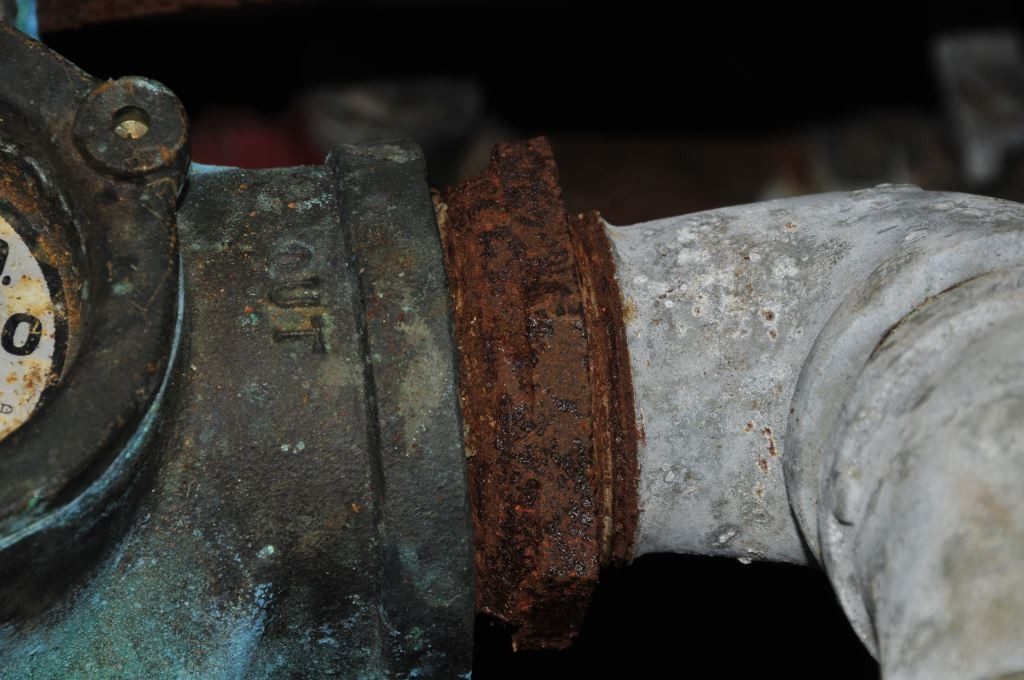
Galvanic corrosion occurs when dissimilar metals are connected and exposed to an electrolyte like seawater. This strainer installation is a textbook example of what not to do, bronze, mild steel and galvanized steel. Not only are these metals incompatible, mild and galvanized steel should not be used for raw water applications.
Corrosion; it’s veritably inescapable and ever-present, yet it is among the most misunderstood of all onboard phenomenon. Hardly a week goes by where I don’t receive a call or e mail regarding a seemingly vexing corrosion problem. And no wonder; virtually every cruising, and small commercial and military, vessel is built using a wide range of metallic components, thereby susceptible to corrosion, from bronze seacocks and iron engine blocks, to stainless steel and aluminum deck hardware and copper wiring. Add water to this mix, especially seawater, or electricity and the results can be heart achingly unpleasant and costly. While a cloud of misconception so often unnecessarily shrouds the truth behind the cause and prevention, of corrosion, it’s not especially difficult for marine industry professionals, and boat owners alike, to gain a working knowledge of this seagoing malady.
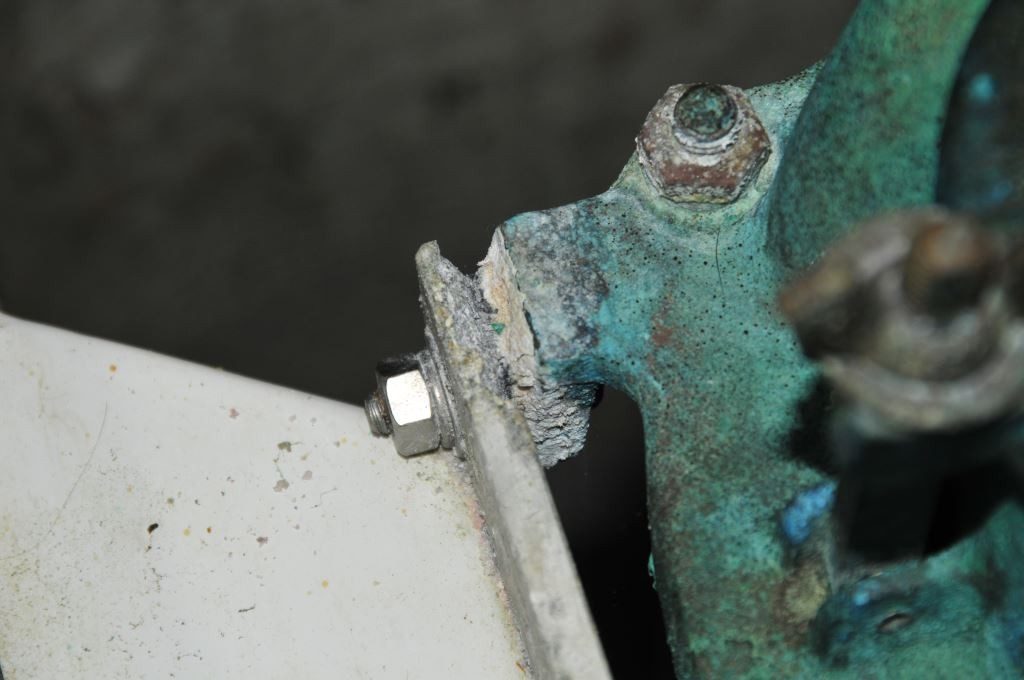
Aluminum and copper alloys like bronze are among the least compatible metals. Here a bronze raw water strainer is supported by an aluminum bracket. Airborne moisture alone would be enough to cause a problem, albeit slowly, however, every time the strainer is serviced, the two metals get doused with seawater, accelerating the corrosion process.
Corrosion’s Yin and Yang
While there are many varieties, which are specific to different metals, from aluminum’s poultice corrosion to stainless steel’s crevice corrosion, there are two overarching mechanisms that affect most vessels. These are galvanic or dissimilar metal, and stray current, corrosion.
Galvanic or Dissimilar Metal
Galvanic corrosion occurs when dissimilar metals are placed in contact with each other, or are otherwise electrically connected via a wire or other conductor, and exposed to an electrolyte, which in this case is simply fresh or seawater, or even high humidity, with seawater’s enhanced conductivity predictably accelerating the process. Galvanic corrosion is electrical in nature, with the electricity being created by the dissimilar metals and electrolyte, much like a battery, albeit at a very low rate, typically measured in thousandths of a volt or millivolts.
While virtually any two metals will interact with each other in this scenario, those that are further apart on the galvanic series or scale will interact to a greater degree, or more aggressively. Metals that are located at the most noble, and most corrosion resistant, end of the galvanic series include exotics such as graphite, gold and titanium, as well as 316 stainless steel, and nickel-chrome alloys used for propeller shafts, while those toward the least noble end of the series, magnesium, zinc, and aluminum alloys, are significantly less corrosion resistant.
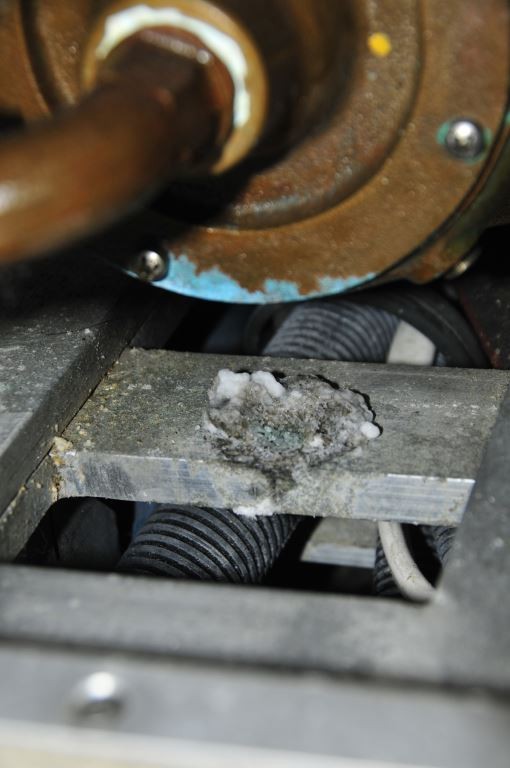
In some cases galvanic corrosion can occur even if metals are not in direct contact with each other; here water dripping from a bronze pump has corroded its aluminum support structure.
Dissimilar metal combinations that are especially problematic include copper (and copper alloys such as bronze and brass) and aluminum, and to a lesser degree stainless steel and aluminum. In fact, because of the nether region it inhabits on the galvanic scale, virtually any metal placed into contact with aluminum, and in the presence of moisture, will cause the latter to corrode. In 1895, before this phenomenon was thoroughly understood from a boat building perspective, the Herreshoff –designed and built America’s Cup contender ‘Defender’, was assembled using a nickel-aluminum alloy hull above the waterline, and bronze plate below the waterline, over steel frames, with bronze rivets throughout, creating a battery-like galvanic mélange. It wasn’t long before it had to be scrapped, the hull plating had pitted so heavily it was no longer seaworthy, (but not before she fulfilled her intended purpose; winning the Cup).
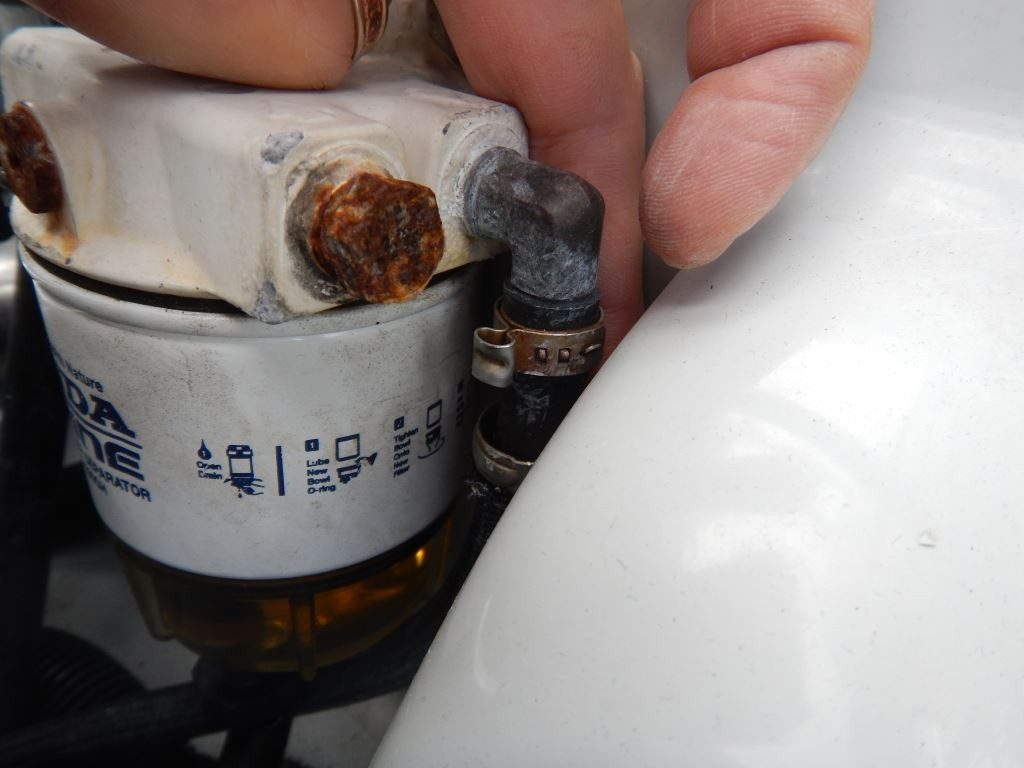
Aluminum fuel filter housings like the one shown here are often plumbed with galvanically incompatible brass pipe to hose adapters, primarily because the latter are readily available. Mild steel plugs have also been used on this installation, they too are inappropriate, all should be stainless steel, and installed with a fuel resistant thread sealant.
Examples of galvanic corrosion that can be found aboard the average vessel include brass hydraulic steering cylinders or bronze seawater strainers supported by aluminum brackets, aluminum fuel filter mounts plumbed with brass fittings (often used on outboard applications, where they are very much exposed to the elements), and to a lesser degree aluminum deck and mast hardware installed using stainless steel fasteners.
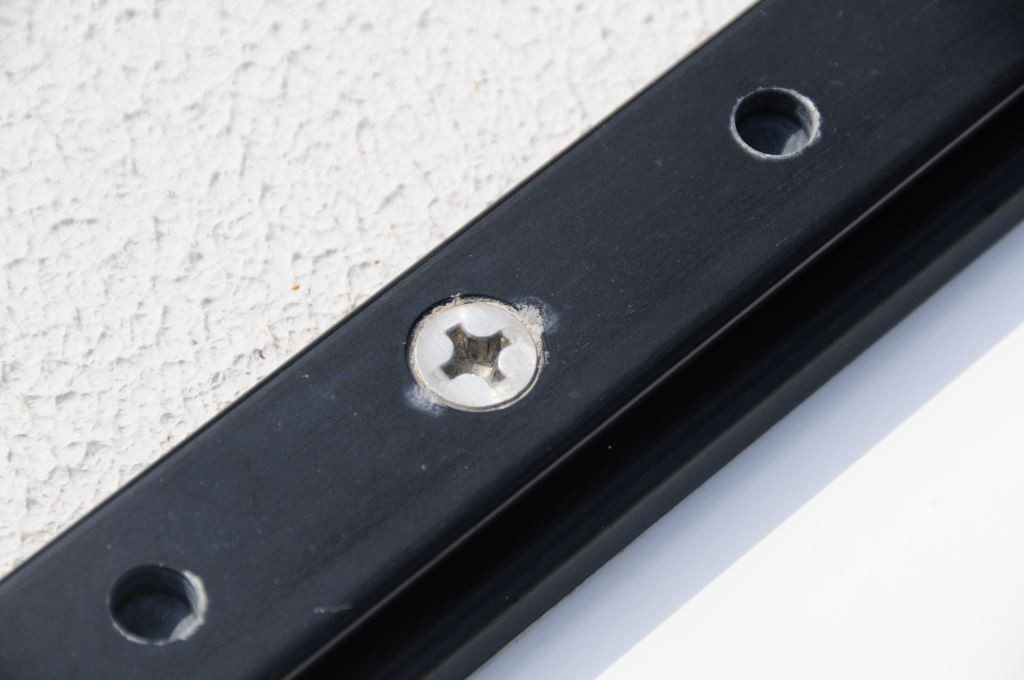
While less of an issue than some other metal combinations, aluminum can suffer from galvanic corrosion when in contact with stainless steel and water. Here, a recessed stainless steel screw traps water, setting up a galvanic cell; corrosion has already begin to set in on this new nearly boat.
However, the very best example of galvanic corrosion is one that’s intentional; sacrificial zinc anodes attached to underwater metals such as propeller shafts, through hull fittings, struts and rudders, and then to the vessel’s bonding system , as well as heat exchangers. The ignoble zinc (zinc is one of three possible sacrificial metals that can be used for cathodic protection, the other two are aluminum and magnesium, zinc should only be used in seawater, and magnesium is suited only to fresh water; while aluminum can be used in fresh, brackish or sea water) corrodes, while protecting the metal to which it’s attached. To learn more about anode selection, see this article.
The most effective means of preventing galvanic corrosion is to avoid using dissimilar metals in scenarios where they will come into contact with each other, or where they are otherwise electrically connected. Where this is unavoidable, inserting between them an insulator, which can take the form of a non-conductive material, or in some cases another metal that is benign to both, is yet another form of galvanic corrosion prevention. Non-conductive materials include pre-fabricated fiberglass or epoxy-based sheet (avoid using non-reinforced plastics such as Starboard in highly loaded structural applications), while stainless steel is often used as an insulator between aluminum and copper-based alloys, between aluminum fuel tanks and brass (a copper alloy) valves for instance. While the two are technically still connected, the stainless steel bushing provides the necessary degree of isolation; however, this approach would not be acceptable for submerged or continuously wetted components, and under no circumstances should brass be used in raw or sea water applications, as it will suffer from yet another type of corrosion, dezincification.
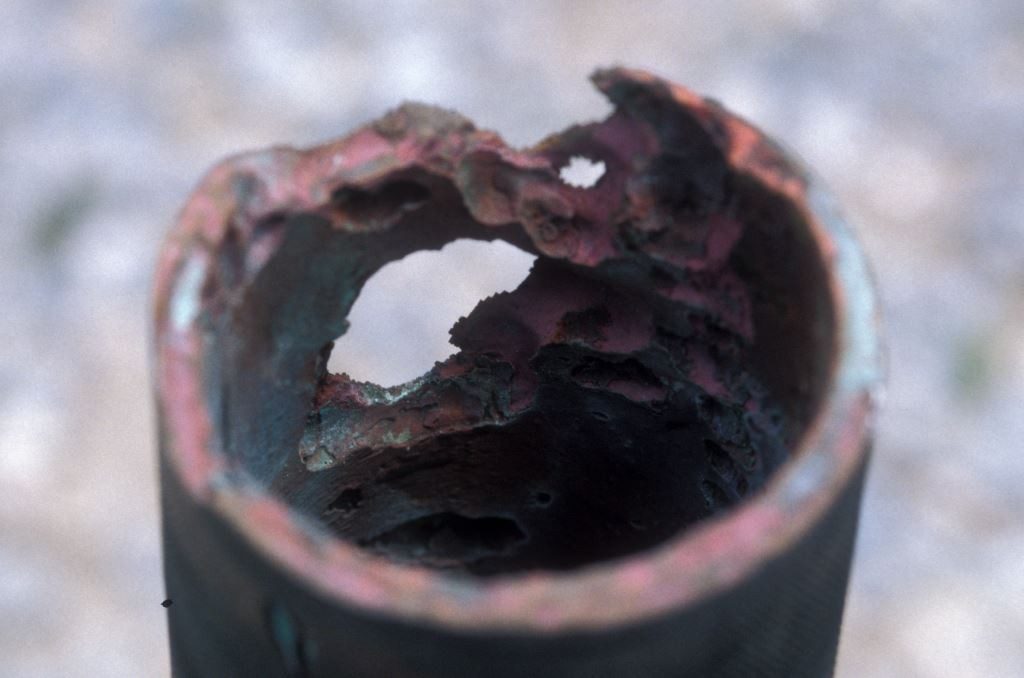
This zinc-bearing brass stern tube is suffering from dezincification, evidenced by its pinkish hue, which is a form of galvanic corrosion.
While galvanic corrosion is typically a localized event, occurring aboard a given vessel from its own dissimilar metals, it can also occur between vessels. This concept can be somewhat confusing and is understandably the source of a great deal of misinformation, including the “hot marina” myth. Inter-vessel galvanic corrosion occurs when, for instance, two vessels, which are near each other both plug into shore power. In doing so the green AC safety ground wiring for each vessel, which are common with bonded underwater metals such as seacocks, struts and shafts, become connected regardless of whether or not the shore power is energized. To reiterate, the moment shore power is plugged in, AC safety grounds and bonding systems between vessels are interconnected. When this occurs, intact sacrificial anodes, or less noble underwater metals such as aluminum stern drives, on one vessel may begin protecting underwater metals on another vessel(s), one whose anodes are depleted. Except for the fact that the shore power cord must be connected, this phenomenon has little if anything to do with the marina, or shore power per se, can occur even if the power is off; it remains a galvanic phenomenon.
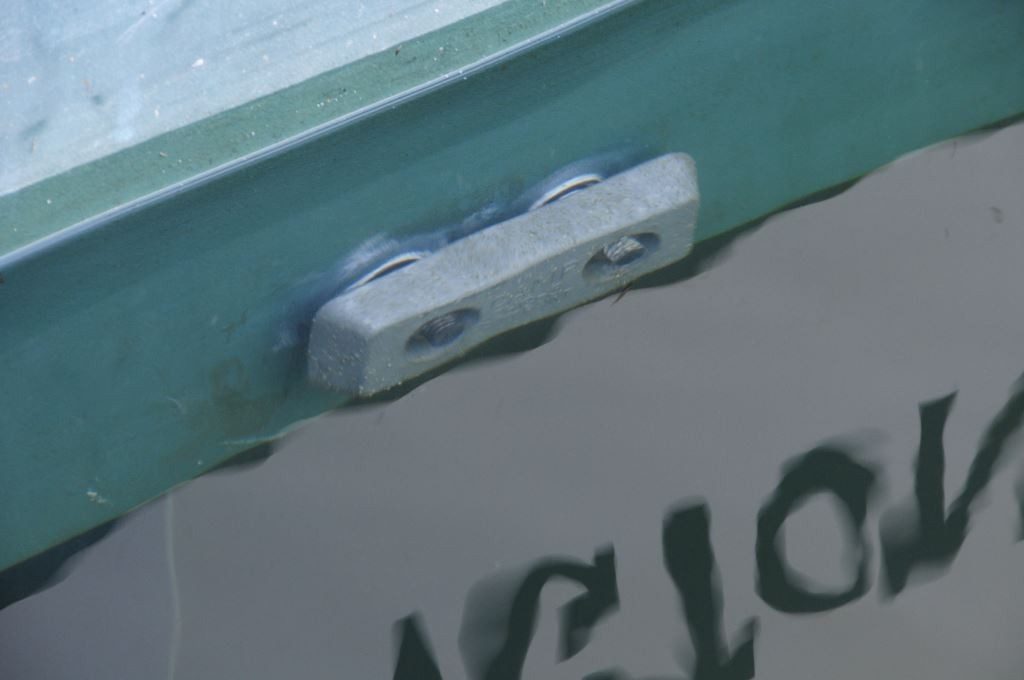
Hull-mounted anodes, these may be zinc, aluminum or magnesium, can be connected to the bonding system, and thereby provide protection for all connected underwater metals.
As insidious as this scenario is, it is easily thwarted using either a galvanic isolator, or an isolation transformer. Galvanic isolators block, up to 1.4 volts (which is above the typical galvanic corrosion voltage threshold), of DC voltage on the AC shore power safety ground wire, while still allowing AC fault current to flow freely, which is critical from a safety perspective. Because galvanic corrosion is DC in nature, the electrical interconnection of adjacent vessels is prevented by the galvanic isolator. Isolation transformers take this a step further, by isolating all shore power connections, including the AC safety ground, between the vessel and the dock, thereby blocking any level of shore power cable-related inter vessel conductivity. Every vessel equipped with a shore power system should utilize one of these devices to prevent shore power safety ground-induced galvanic corrosion. Galvanic isolators are relatively inexpensive, while transformers are more costly; the latter however, offer additional benefits in addition to absolute isolation.
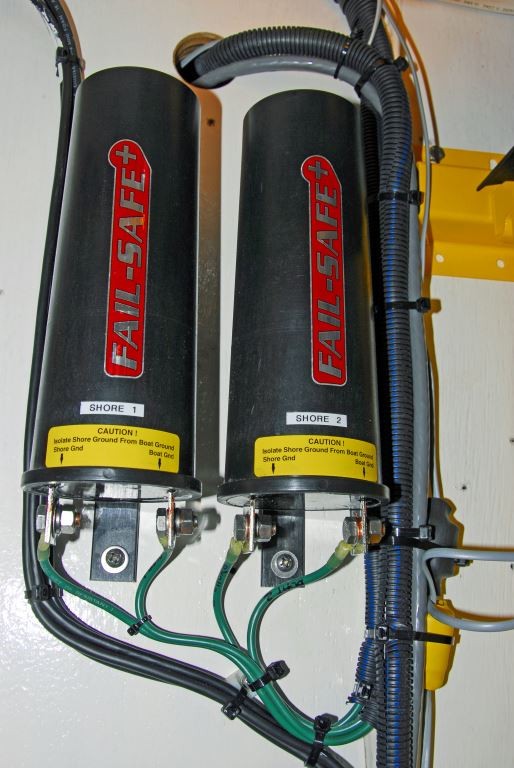
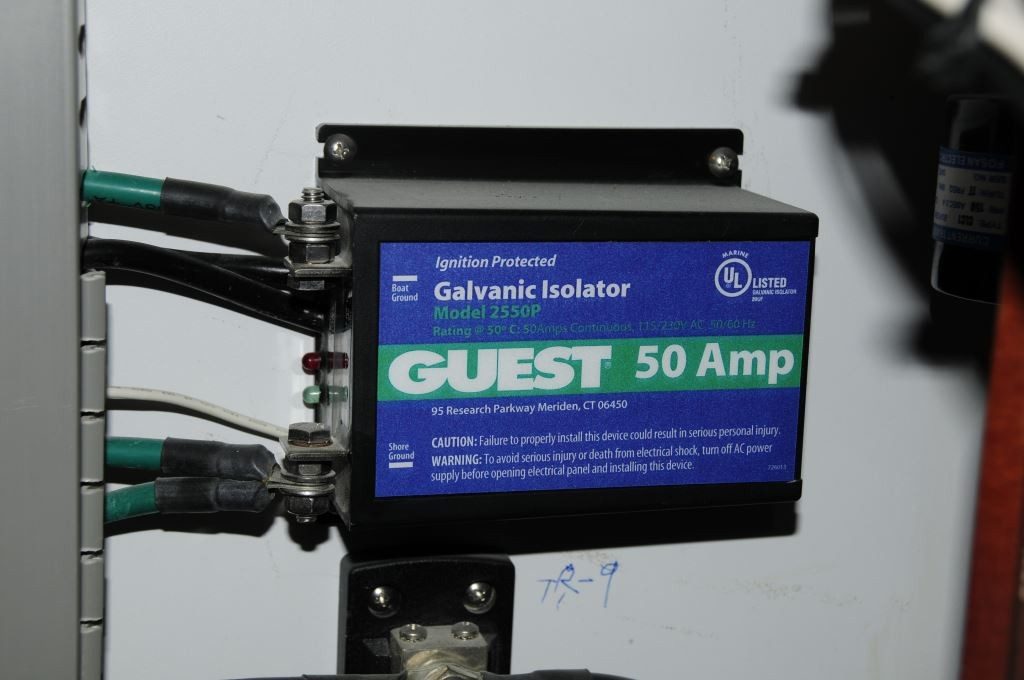
Galvanic isolators are the first line of defense against galvanic corrosion that originates aboard nearby vessels. They are comparatively inexpensive, and easy to install, every vessel equipped with shore power should have one. The one you select should meet ABYC Standard A-28.
While it is a potentially serious and costly phenomenon, galvanic corrosion occurs at a stately pace, typically over the course of weeks if not months and years. With proper alloy selection, isolation and cathodic protection, it can be minimized if not eliminated.
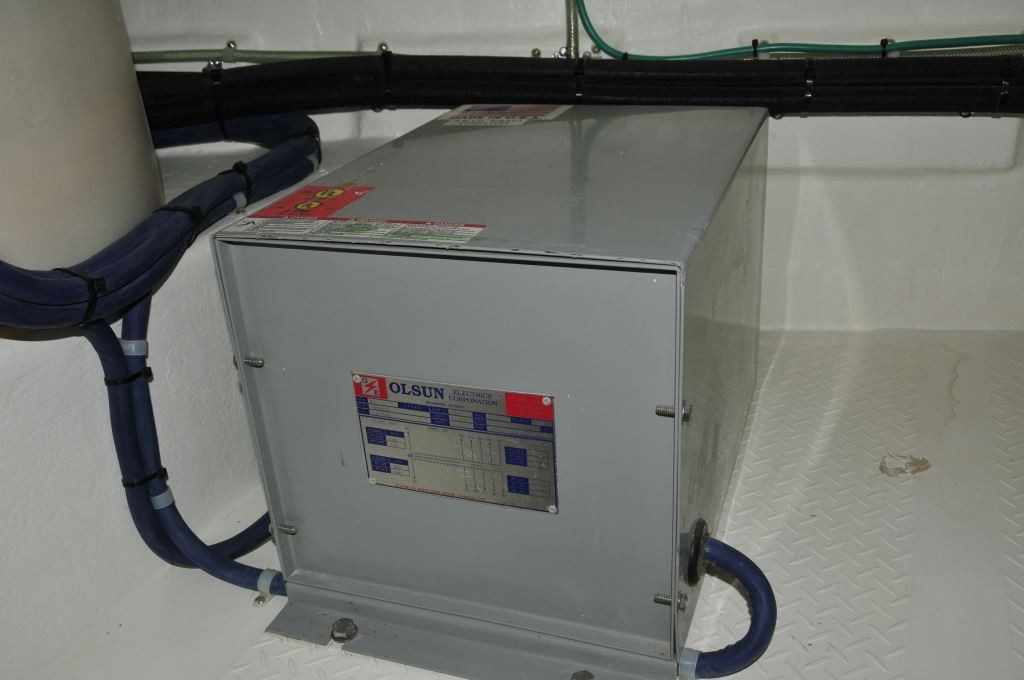
Shore power transformers, when wired in isolation mode, provide an effective and all but impenetrable barrier to corrosion that originates on other vessels, or in places other than aboard the vessel on which they are installed.
Stray Current
This form of corrosion differs from galvanic corrosion in that it only occurs in the presence of an outside source of electricity; which is, with very rare exceptions, a vessel’s own DC electrical system, or battery or battery charger. Shore power, i.e. AC voltage, does not, again with very rare exceptions, cause this type of corrosion. If it did, the DC voltage blocking ability of a galvanic isolator would be ineffective. Rare though it may be, when it does occur, AC-induced stray current corrosion is of greatest concern where aluminum-hulled vessels are concerned, as well as those equipped aluminum stern drives.

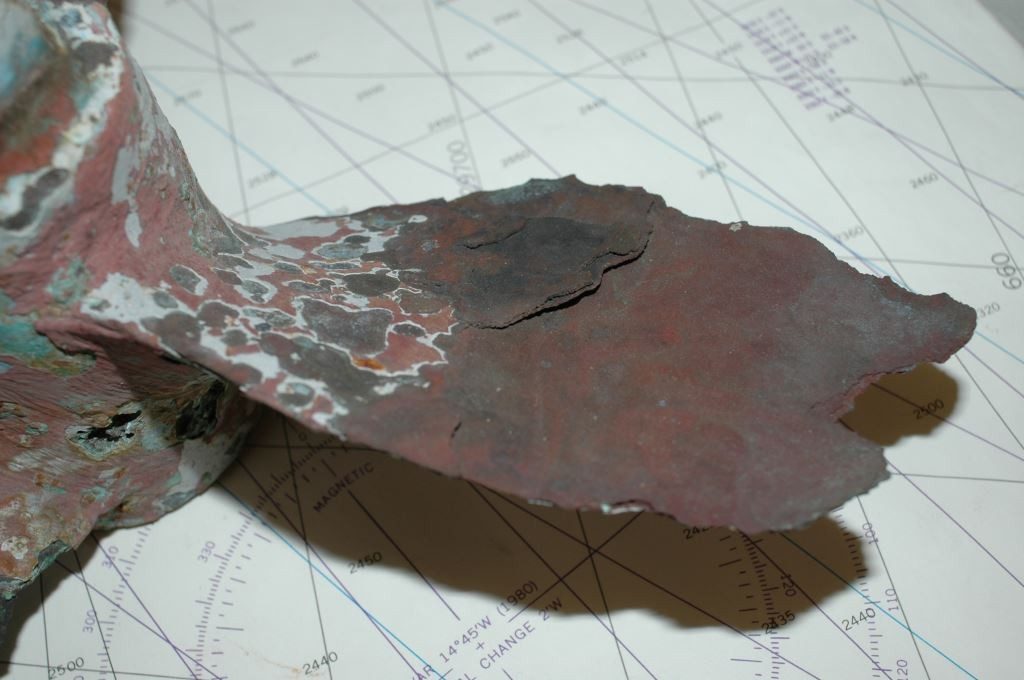
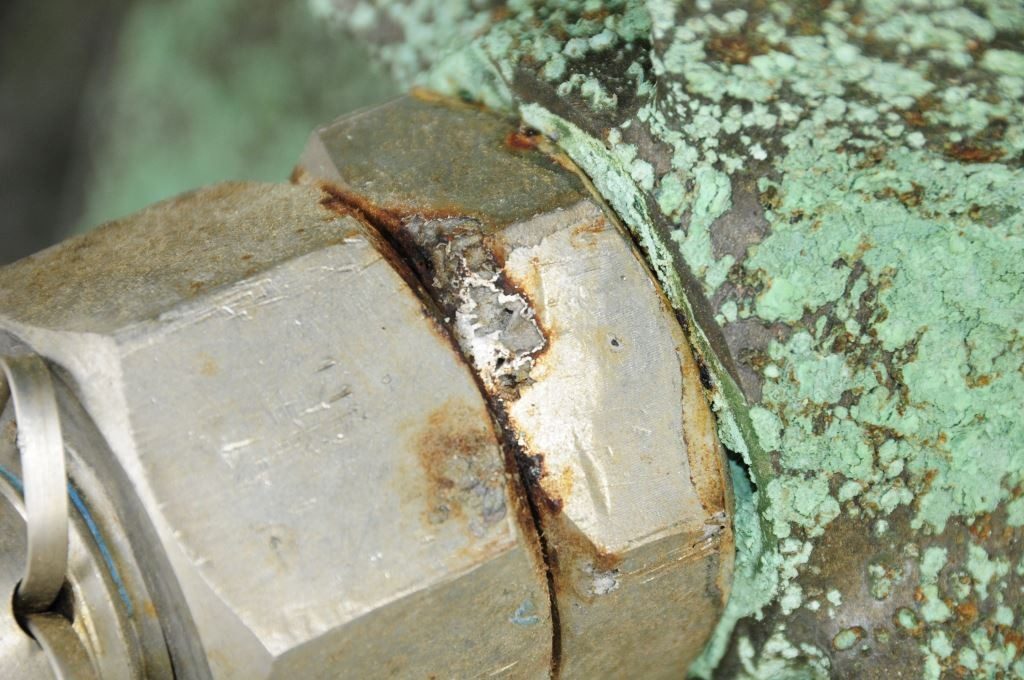
Stray current corrosion is extremely destructive and it occurs comparatively quickly, it qualifies as a corrosion emergency, as it’s capable of impacting a vessel’s watertight integrity in a matter of days if not hours.
The typical stray current corrosion scenario involves a faulty electrical connection that is located in, or close to, bilge water or one that makes contact with a submerged metal. Contrary to popular belief, electricity does not seek ground; it seeks a return path to its source. In the case of stray current corrosion that’s the vessel’s battery. Current leaking into bilge water may travel to a through hull fitting, then into the water in which the vessel is floating, then on to the propeller and shaft, which are grounded to the DC negative system via the engine block, and thence back to the battery. In this example, the propeller will almost certainly suffer from severe and rapid corrosion. Unlike galvanic corrosion, which occurs comparatively slowly, stray current corrosion moves with startling rapidity, potentially destroying a propeller, shaft, thruster, sail drive or stern drive in a matter of days.
Sacrificial anodes, galvanic isolators, and isolation transformers offer little if any protection against this electrical scourge (isolation transformers can be beneficial for preventing stray current corrosion that originates on other vessels). The most effective means of preventing stray current corrosion is by observing sound, American Boat and Yacht Council (ABYC) -compliant wiring practices, particularly in and around bilge areas. Bilge pump and float switch connections should be made no less than 18 inches above the base of the pump. The primary reason for doing so is to improve reliability; however, this approach also reduces the likelihood of stray current corrosion. If this is impractical, then connections should be made completely water-proof using heat shrink butt splices or stand-alone heat shrink tubing, and if necessary application of silicone sealant, and connections should never be allowed to lay in bilge water, regardless of water resistance. A detail as seemingly innocuous as improperly crimping, and thereby piercing, a heat shrink butt splice can create a path through bilge water for stray current. While this applies to all electrical junctions made in the vicinity of bilges, stray current corrosion can occur virtually anywhere aboard a vessel when a positive DC conductor makes contact, directly or indirectly, with a submerged metallic structure.
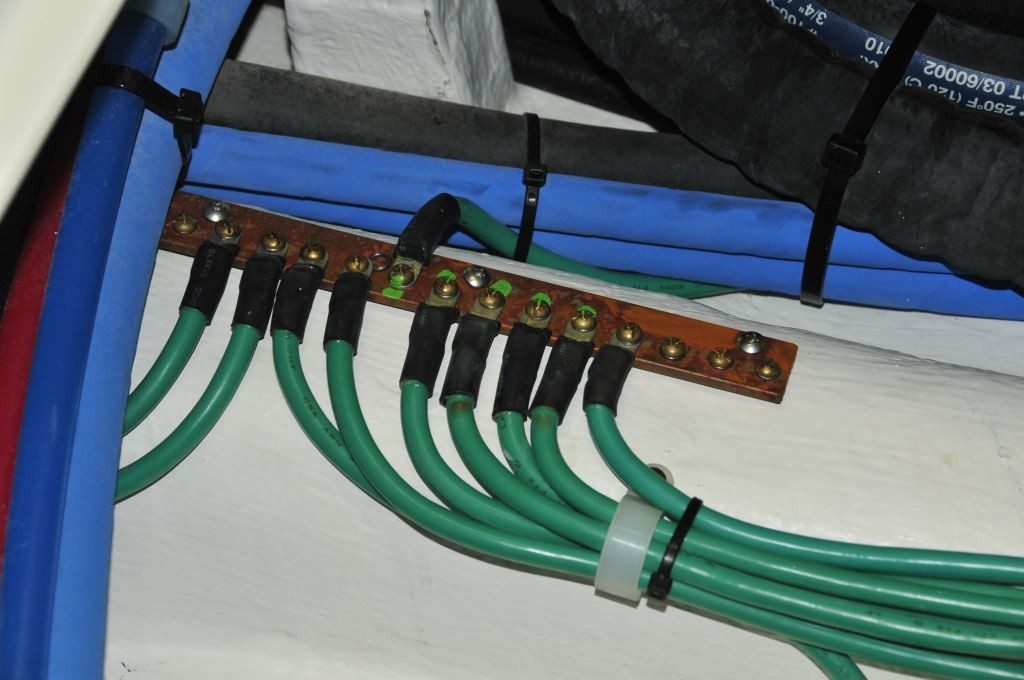
Bonding systems are an essential part of a fiberglass vessel’s ability to prevent or minimize corrosion.
Yet another means of preventing or diminishing the effects of stray current corrosion involves the use of a bonding system (where fiberglass vessels are concerned, bonding systems are strongly recommended; their installation guidelines are detailed in ABYC Standard E-2, “Cathodic Protection”). Bonding systems are one segment of a vessel’s overall grounding system, which encompasses the DC negative, AC safety ground, and lightning ground systems, all of which are inter-connected.
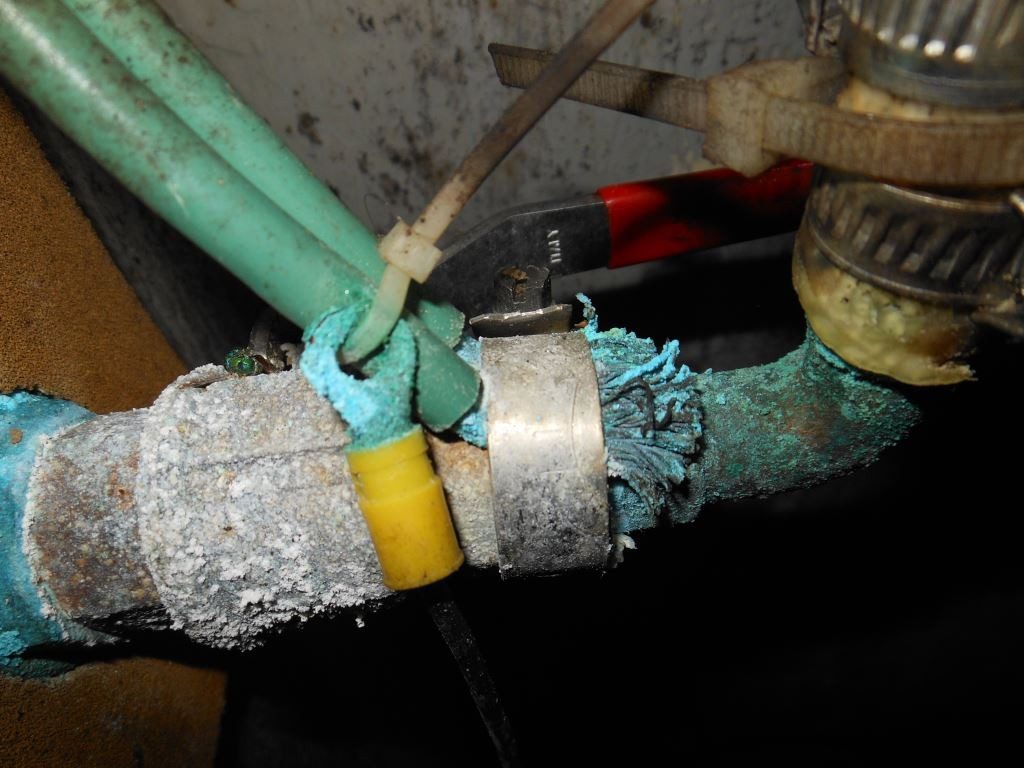
Bonding system connections live a difficult life, they are often located in bilges and exposed to water and foot traffic. Bonding connections should rely on machine screw connections, rather than on tapping screws or hose clamps.
In brief, a bonding system electrically interconnects underwater metals and many metallic machinery components, including through hull fittings and seacocks, rudder and propeller shafts, struts, and strainers. There are two primary benefits to bonding; with the first being the mitigation of stray current corrosion.
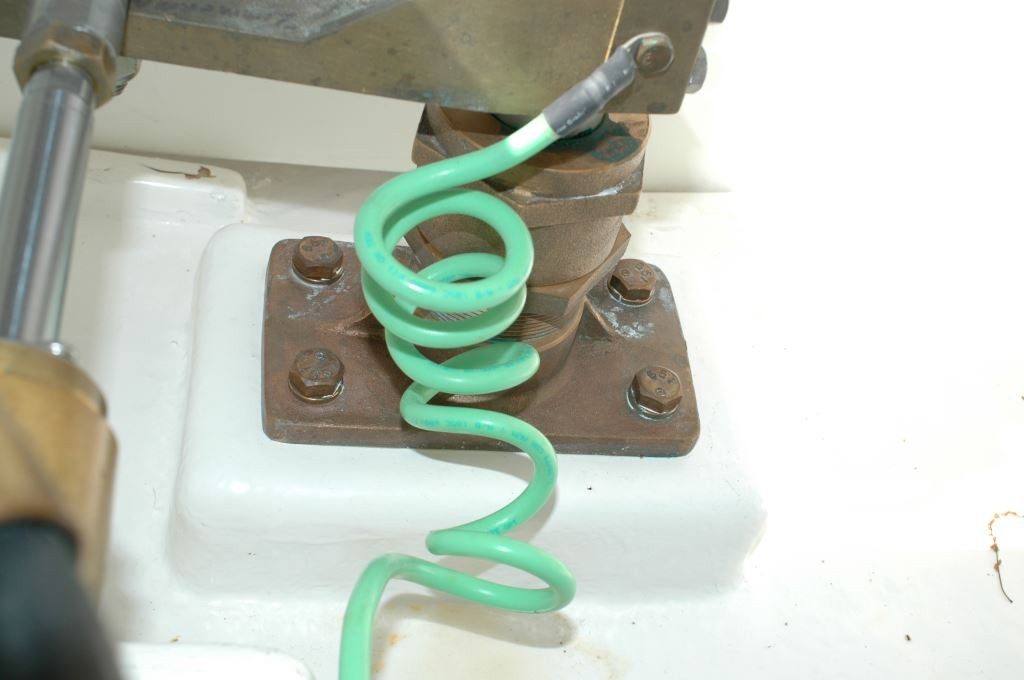
Moving components, like the rudder post shown here, require some special techniques for making long-lasting bonding connections.
In the scenario described previously, wherein voltage is “leaking” into bilge water from a defective bilge pump connection, if the seacock through which the fault current flowed was bonded, all or most of the current would return to its source, the battery, rather than through the water in which the vessel floats, thereby eliminating or minimizing the damage to the propeller.
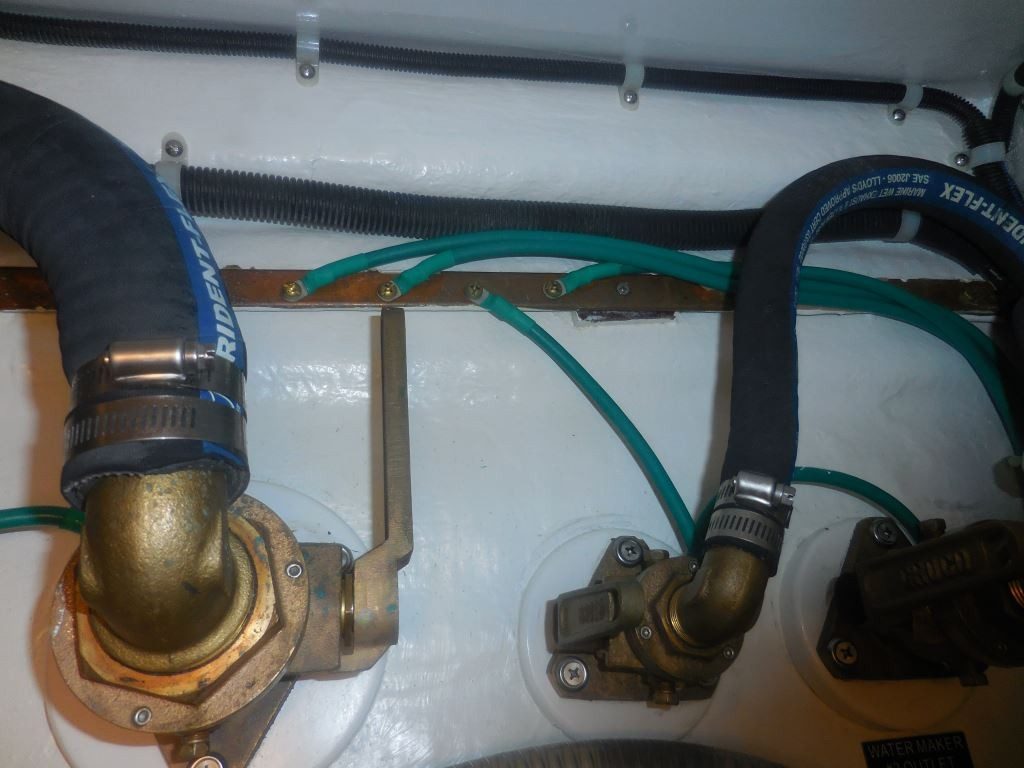
Using the “home run” system, where each bonded component is wired directly to a bonding bus, is an ideal approach that typically yields low resistance connections.
The second benefit to utilization of a bonding system relates back to galvanic corrosion and its prevention. Bonded metals are nearly always dissimilar, silicon bronze seacocks, stainless steel alloy shafts, and manganese bronze propellers for instance, which violates the aforementioned guidelines on galvanic corrosion. Bonding systems, however, are an exception to this rule with good reason; one additional component is included in this metal cocktail, a sacrificial hull-mounted zinc, aluminum or magnesium anode. These are commonly installed on the transom of planing vessels, and on hull bottoms, sometimes recessed, on displacement vessels. Connecting underwater metals to each other, and then to an anode follows the ‘bond and protect’ protocol, a proven approach that works provided a handful of guidelines are followed. Chief among these is ensuring low resistance connections are made between bonded components and hull anodes, the standard for which, established by ABYC, is stringent indeed, a maximum of just one ohm.
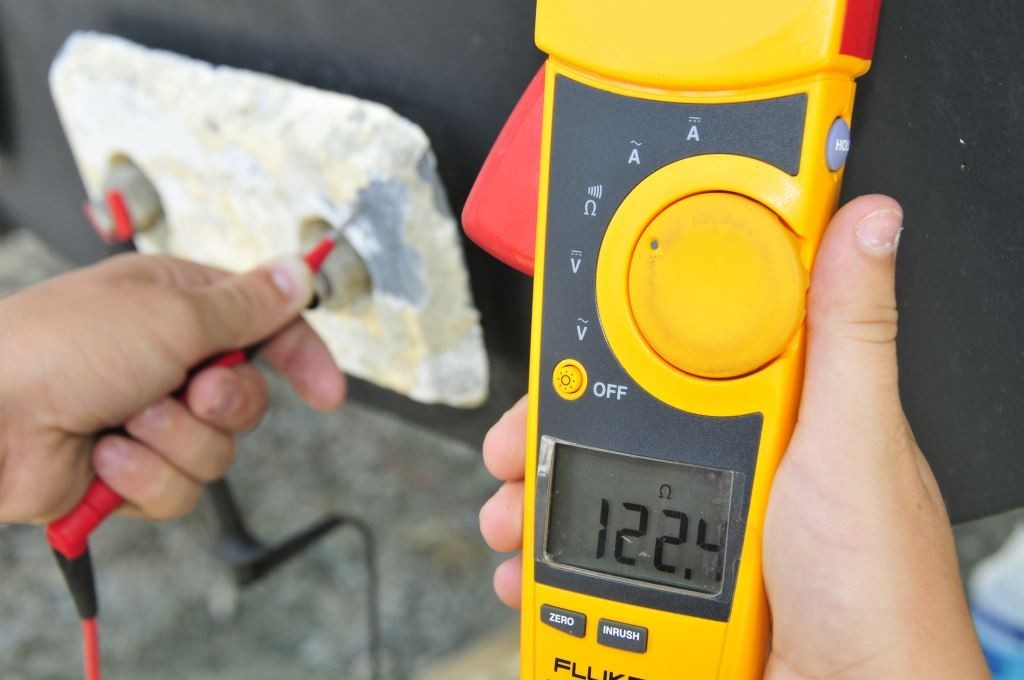
Resistance between protected underwater metals and sacrificial anodes must be kept to a minimum, no more than one ohm (this one fails to meet that standard), in order for protection to be afforded.
Aboard the vast majority of vessels I inspect, bonding systems, and their connections specifically, are in abominable condition, they are green, crusty, loose or broken all together. Like any other system aboard your vessel, the bonding system should be periodically inspected and maintained. Corroded or otherwise poor connections should be cleaned or replaced. If doubt exists about the integrity of the system, resistance between components should be checked, while the vessel is hauled out, using an ohm meter.
Corrosion, and its prevention, need not be mysterious, and while its analysis is often deemed a black art, it is in fact anything but; its causes have been studied and are very clearly understood. While the above guidelines will help prevent the most commonly encountered corrosion mechanisms, if your corrosion problem defies explanation, only entrust its analysis to an ABYC certified corrosion specialist.

